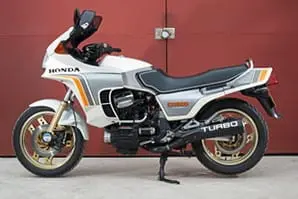
There’s an old story about asking directions from a village yokel who has little real idea of your intended destination. Lost motorist – “Can you tell me the way to Reading please?” Yokel – “Reading is it? Well, I wouldn’t be starting from here sir!” The same cack-handed logic might also be applied to this month’s subject matter.
A V-twin was unquestionably never a prime candidate for turbocharging. Turbines and compressors are at their happiest when they have a constant and consistent source of energy; this is why the competition all signed up to inline fours.
However, we have to remember this is Honda we’re talking about here; it simply was not going to be defeated by the lumpy and irregular power pulses of a V-twin. Of course, such motors had been equipped with pressurised induction before, but never for day-to-day use on public roads. Bolting a blower onto a Brough or Jap pre-war might have been the done thing, but only if you were expressly racing. Honda’s resultant machine was, and remains, a technical tour de force.
The bike was very much a showcase for the company’s prowess and was used as both a statement of Honda’s return to the bike world proper and its overt technical abilities. Resonance chambers, plenum boxes, surge tanks, fuel injection, micro electronics and more than 230 patents pretty much assured the bike-buying public this was a top drawer product. Even the turbo was specially built by Ishikawajima (IHI), which developed the 50mm turbine/48mm compressor unit specifically for the job.
 At its inception the CX500 Turbo carried the world’s smallest exhaust-driven, forced induction unit. Although the CX’s engine cases were deemed strong enough, almost all of the cooling system had to be upgraded to deal with the new engine’s latent heat potential. While they were at it, Honda’s boffins also opted for another first off: forged pistons.
At its inception the CX500 Turbo carried the world’s smallest exhaust-driven, forced induction unit. Although the CX’s engine cases were deemed strong enough, almost all of the cooling system had to be upgraded to deal with the new engine’s latent heat potential. While they were at it, Honda’s boffins also opted for another first off: forged pistons.
Further R&D focused on improving the chassis for the massive power hike. Anti-dive forks, a wind tunnel- designed fairing, a change in wheel size and countless other upgrades lifted the quirky CX500 to the level of an almost mystical machine.
Okay, so the bike is regarded as an oddity 30 years on, but for a brief period this looked very much like the future of modern motorcycling. Motorcycle Mechanics dubbed Honda’s new machine ‘the 500 that thinks it’s a 900’. Such was the poke delivered that, at the time, it caught out some unwary journalists when everything came together post 4000rpm.
Turbo lag was already a phrase many were picking up and the one- or two-second delay between opening the taps and getting the hit was something riders were being educated to expect. Comfort was good, as was wind protection behind the fairing. Even handling was generally viewed as good, if a little heavy at speed. It was only the slightly ponderous, top-heavy feel, inherited from its normally aspirated cousin, that belied the bike origins, and no amount of clever R&D would ever be able to engineer out the defining limits of a transverse water cooled V-twin.
Three decades later we all know the concept was a flash in the pan, smoke and mirrors, flim flam and quite possibly bordering on the edge of artful deception. However, if you want to buy into the mystique of a turbocharged motorcycle there is probably very little that aces the Honda. Stunning build quality, meticulous attention to detail, outstanding reliability (it is a Honda after all) and, perhaps amazingly, dogged longevity.
Obviously, once again sold as a flagship model, the entire machine was made to an extremely high and exacting standard. A significant number of CX500 Ts have spent a large part of their lives in museums or top-end garage storage, yet with a fresh charge in the battery they normally fire up and run as sweetly as they did back in the day.
The bike was never intended to be an out-and-out sports machine; buy or ride one with such intentions and you are likely to be sorely disappointed. It’s not so much thoroughbred flat racehorse, more quality Arabian with good endurance and a winning temperament.
The pros and cons of forced induction
There are huge potential benefits to be had from forced induction on almost any four-stroke motor.
Within reason the more fuel/air that can be crammed into a cylinder the better the engine will perform. However, there are also several caveats.
Increased pressure within the combustion chamber normally demands a reduction in compression ratio and with increased power comes increased heat, so issues with overheating and pre-ignition also have to be taken into consideration. Extra power often warrants upgrading key parts to increase their strength, which in turn may add mass. Then there’s the method of compressing the air.
Turbochargers wo rk off the exhaust gases by spinning up a turbine that is connected to, but sealed from, the compressor that draws in the extra air. Turbos effectively utilise an energy source that would otherwise be wasted. However, their boost potential is governed to a large degree by the speed of the existing exhaust gases, which is where we get the infamous turbo lag from. This is why turbos tend to work best at higher revs.
rk off the exhaust gases by spinning up a turbine that is connected to, but sealed from, the compressor that draws in the extra air. Turbos effectively utilise an energy source that would otherwise be wasted. However, their boost potential is governed to a large degree by the speed of the existing exhaust gases, which is where we get the infamous turbo lag from. This is why turbos tend to work best at higher revs.
Superchargers don’t offer the apparent something-for-nothing benefit seen in turbos – they are generally driven either directly or indirectly off the crankshaft. This means they sap some power, but their advantage is that they work from almost zero revs and their boost ability is almost instantaneous. It is possible to use forced induction on two strokes to devastating effect as shown by DKW’s pre-war racing bikes. However, modern emission regulations sadly mean we are unlikely to see a blown stroker on general sale.
There have been rumours afresh lately that once again the Japanese motorcycle industry might be looking at forced induction. Most modern diesel cars run turbos and are now cleaner than the equivalent petrol engine. With modern micro electronics we might just see smaller-capacity motorcycles kicking out ludicrous amounts of power… bring it on! ![]()












